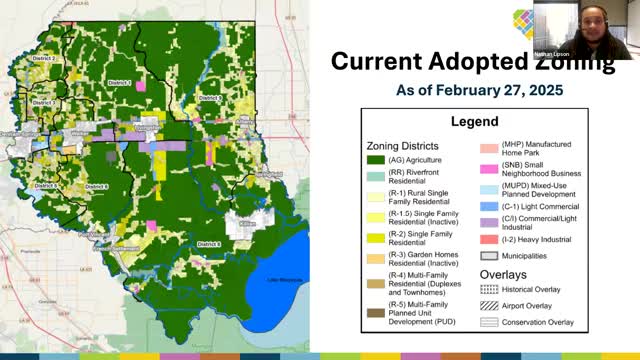Livingston Parish Unveils Future Land Use Map to Guide Development and Conservation
September 24, 2025 | Livingston Parish, Louisiana
This article was created by AI summarizing key points discussed. AI makes mistakes, so for full details and context, please refer to the video of the full meeting. Please report any errors so we can fix them. Report an error »

In the heart of Livingston Parish, a pivotal meeting unfolded, focusing on the future of land use and zoning in the community. As local officials gathered, the atmosphere buzzed with anticipation, underscoring the importance of thoughtful planning in shaping the parish's landscape.
The discussion began with Nathan, a key figure in the planning process, emphasizing the power of zoning as a tool for guiding development. He highlighted the necessity of aligning zoning types with existing conditions and future potential, setting the stage for a comprehensive examination of land use in the area.
Abe took the floor next, presenting the current land use map of Livingston Parish. This map illustrates the distribution of undeveloped open spaces alongside developed areas, categorized into various types such as residential, agricultural, and wetlands. The color-coded legend serves as a visual guide, helping stakeholders understand the spatial relationships within the parish. Abe stressed that grasping the current land use patterns is crucial for informed planning, ensuring that future development aligns with community goals and environmental considerations.
The conversation then shifted to proposed future land use categories, which outline how different areas are intended to be utilized. Conservation areas, where development is discouraged, aim to protect natural habitats. Agricultural zones support farming and low-density residential living, while rural corridors allow for small-scale commercial activities alongside homes. This framework is designed to promote balanced growth while preserving the parish's natural and rural character.
Further discussions introduced suburban and mixed-use developments, which are planned for areas with higher density housing and neighborhood-serving commercial uses. These developments will include necessary infrastructure, such as sidewalks and parks, to enhance community living. Mixed-use water zones will allow for residential and recreational uses near water bodies, incorporating environmental safeguards.
The meeting culminated in the unveiling of a proposed future land use map, visually representing how different areas are planned for development or preservation. This map, with its distinct colors for conservation zones, rural areas, and urban districts, provides a clear framework for managing growth. It serves as a critical tool for guiding zoning decisions and infrastructure planning, balancing development with environmental protection and community character.
As the meeting wrapped up, the sense of collaboration and forward-thinking was palpable. The discussions held in this gathering will undoubtedly shape the future of Livingston Parish, ensuring that growth is managed thoughtfully and in harmony with the community's values and natural surroundings.
The discussion began with Nathan, a key figure in the planning process, emphasizing the power of zoning as a tool for guiding development. He highlighted the necessity of aligning zoning types with existing conditions and future potential, setting the stage for a comprehensive examination of land use in the area.
Abe took the floor next, presenting the current land use map of Livingston Parish. This map illustrates the distribution of undeveloped open spaces alongside developed areas, categorized into various types such as residential, agricultural, and wetlands. The color-coded legend serves as a visual guide, helping stakeholders understand the spatial relationships within the parish. Abe stressed that grasping the current land use patterns is crucial for informed planning, ensuring that future development aligns with community goals and environmental considerations.
The conversation then shifted to proposed future land use categories, which outline how different areas are intended to be utilized. Conservation areas, where development is discouraged, aim to protect natural habitats. Agricultural zones support farming and low-density residential living, while rural corridors allow for small-scale commercial activities alongside homes. This framework is designed to promote balanced growth while preserving the parish's natural and rural character.
Further discussions introduced suburban and mixed-use developments, which are planned for areas with higher density housing and neighborhood-serving commercial uses. These developments will include necessary infrastructure, such as sidewalks and parks, to enhance community living. Mixed-use water zones will allow for residential and recreational uses near water bodies, incorporating environmental safeguards.
The meeting culminated in the unveiling of a proposed future land use map, visually representing how different areas are planned for development or preservation. This map, with its distinct colors for conservation zones, rural areas, and urban districts, provides a clear framework for managing growth. It serves as a critical tool for guiding zoning decisions and infrastructure planning, balancing development with environmental protection and community character.
As the meeting wrapped up, the sense of collaboration and forward-thinking was palpable. The discussions held in this gathering will undoubtedly shape the future of Livingston Parish, ensuring that growth is managed thoughtfully and in harmony with the community's values and natural surroundings.
View full meeting
This article is based on a recent meeting—watch the full video and explore the complete transcript for deeper insights into the discussion.
View full meeting
